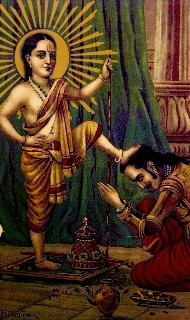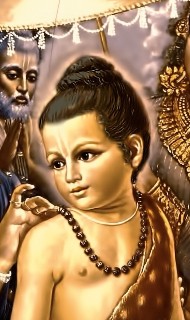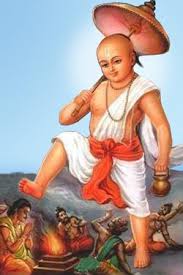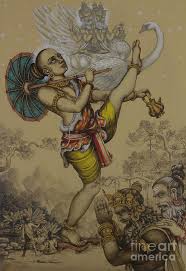From Anuj P
Answer Podcast
Transcription :
Transcriber: Suresh Gupta
Edited by: Raji Nachiappan
Question: How can we differentiate between a dharmic and a fanatic?
Answer: The difference is in the attitude towards other people who do not share one’s faith. The difference is also in one’s own internalisation, realisation of the principles one is teaching as well as in the alignment of one’s belief with actual truth. These points are elaborated below.
Firstly, the word fanatic is used for a person who is intolerant. Those who consider their way as the only way and those who endeavour to destroy other forms of worship considering them to be false can be termed as fanatical.
Several religions, including some of the most influential religions in the world today, are exclusivist. They believe that their way is the only way to God. When they ideologically believe that their way is the only way, then from exclusivism to go towards fanaticism is quite easy and quick. All the Abrahamic religions like Christianity, Islam and Judaism, in their mainstream denominations, are exclusivist in nature. Not all of them are fanatical, but they do tend to become fanatical over a period of time. In the Indian history, we find that when the Portuguese came to Goa, they annihilated, tortured and destroyed thousands of Hindu practitioners because they considered all the Hindu beliefs to be fake. The way Muslims desecrated temples in India is another example from history. If the belief is, that our way is the only way and all other ways are false, then it does not require much stretch of effort for it to become fanatical. Since, Islam and Christianity are the world’s biggest religions today and because both have exclusivist ideologies, that is why religion in general has been equated with fanaticism. The moment somebody is strictly adherent, that person is termed as a fanatic. We are not saying that all people who belong to the above-mentioned religions are fanatics. Since their main stream belief system is exclusivist which more often than not lead to fanaticism.
When we look at the Vedic culture, the Vedic belief system is not exclusivist. That is the most fundamental and defining difference. The Vedic system does not say that this is the only way. If we look at the Bhagavatam, it says that whichever path teaches one to develop love of God, that is the supreme dharma. In the Vedic culture itself, we see that there are many gods worshiped and many methods of worship. There is flexibility of both sadhya and sadhana. Flexibility of sadhya means people can choose their object of worship. It can be Brahman, Paramatma or Bhagavan or they can choose different devatas to worship. Similarly, there is flexibility of sadhana which means people can choose their method of worship. It can be karma yoga, dhyana yoga, bhakti yoga, karma kanda etc. In the Vedic culture, Srila Prabhupada for example, accepts Jesus as a guru because he had love of God. Therefore, the ideology of the Vedic followers is not exclusivism but inclusivism.
When we say that there is flexibility of sadhya and sadhana, it does not mean that all sadhya and sadhana are equally valid. There is a hierarchy. Krishna says in the Bhagavad Gita that while there are multiple paths, all of which are ultimately meant to come to him, there are certain paths which are more desirable than others. Also, while Lord Krishna in BG 4.11 says that all people are on my path, he does not simplistically say that all paths come to me. All paths are ultimately meant to come to him but there is a possibility that they may not come. In 9.25, Lord Krishna says: yaanti deva-vrata devaan pitrin yaanti pitra-vrataah bhutaani yaanti bhutejya yaanti mad-yaajino ’pi maam – which means that different paths lead to different destinations. Hence, the inclusivist idea is that there are multiple paths and there are different levels.
Since Vedic culture is not exclusivist in its ideologies hence the tendency to become fanatical within that is much lesser. However, it is still possible that fanaticism can result when people use religion as a tool for boosting their own ego. The tendency to think that I am great because my religion is the greatest can very easily lead to fanaticism. There can be instances of fanaticism, as an extension of this mentality in Vedic culture too. However, the fundamental difference is that, in the Vedic thought process, fanaticism will not be the natural outgrowth of the central beliefs. It will be a result of the imposition of selfish agendas on the belief system. Attitude towards others faiths is important and Vedic culture has a tolerant and inclusive attitude towards them.
Secondly, the aspect of one’s internalisation and realisation of the path is important. Often, when religion becomes a tool for asserting one’s authority and power, then one focuses on religion more as a tool for external aggrandisement than for inner development. When a practitioner of a religion transforms oneself through realization of spiritual happiness, then such an experience will prevent one from becoming fanatic. When one goes deeper to taste the spiritual reality, then one can see how different spiritual paths have a common essence. As long as we are in the superficial externals, we will only see differences. If we delve deep within, then we will see that ultimately all paths are meant to help us develop love of God. Those who actually practice religion and achieve spiritual happiness can see the essential similarity. Those who do not practice, quite often, are the people who fight.
Also, we should not mistake or conflate fanatical focus with fanaticism. Fanatical focus means diligent, one pointed, intense practice that is required for success in any field. If a sports person want to be successful in a sport, they need to focussed on one game. If they keep shifting their focus to different games how can they achieve success in any one of those. If the person is serious about achieving success, they need to stick to one sport and practice diligently.
The different religious systems are also compared to different treatment systems like allopathy, ayurvedic treatment, naturopathy or homeopathy. A patient cannot expect to be cured by shifting its focus, say take allopathy for three days, ayurveda for four days, homeopathy for a few days, and then naturopathy for the next few days. If the patient wants to be cured, then they have to focus. Such focus is not fanaticism. Also, just because a patient diligently sticks to one particular treatment system does not mean that the patient derides or rejects the other. Similarly, because a person is following a path seriously that does not necessarily mean they reject other religions or that the person is fanatic.
Being fanatically focused means, strictly following the path one has chosen. Fanaticism means, one is intolerant, offensive and even destructive towards other paths and their followers.
When one is fanatically focused, then one gets realisation. For a realized person, superficial differences do not matter as much. However, when one is not realized, then one sees only on the external platform and then one sees only the differences.
Finally, and most importantly, is the aspect of what is the actual truth. There can be people who can fanatically believe in false things and there are people who sincerely believe in true things. The scriptures give the ultimate truth and to the extent, we understand the truth, not just at the intellectual level but at a level of realisation, then we do not become fanatical. At that stage, one develops compassion because one feels connected to the family of God and wants to extend that connection and love of God to all living beings.
In summary, by the attitude shown towards other faiths, by the determined practice of one’s own path and by the alignment of one’s beliefs with reality, one can differentiate between a dharmic person and a fanatic. There are many questions on this website that deal with this issue much further, especially in the category of different world religions. Further questions to understand, how different faiths co-relate has been expanded in a series of lectures, titled, ‘Krishna consciousness and world religions’ which is available on this website.
End of transcription.
The post How can we differentiate between a dharmika and a fanatic? appeared first on The Spiritual Scientist.




 By Giriraj Swami
By Giriraj Swami By His Divine Grace A.C.B. Swami Prabhupada
By His Divine Grace A.C.B. Swami Prabhupada


















 By Bhakti Charu Swami
By Bhakti Charu Swami By Ananda Tirtha Das
By Ananda Tirtha Das


 Jaya Sila das and Vimala Devi Dasi: There is a world of difference between guiding with love and controlling with force. The recipient can certainly feel the difference. A husband is expected to offer spiritual guidance to his wife. Parents need to guide their children. As a teacher, I also have the responsibility of guiding my students. The problem occurs when we insist and rely on force and control.
Jaya Sila das and Vimala Devi Dasi: There is a world of difference between guiding with love and controlling with force. The recipient can certainly feel the difference. A husband is expected to offer spiritual guidance to his wife. Parents need to guide their children. As a teacher, I also have the responsibility of guiding my students. The problem occurs when we insist and rely on force and control.













